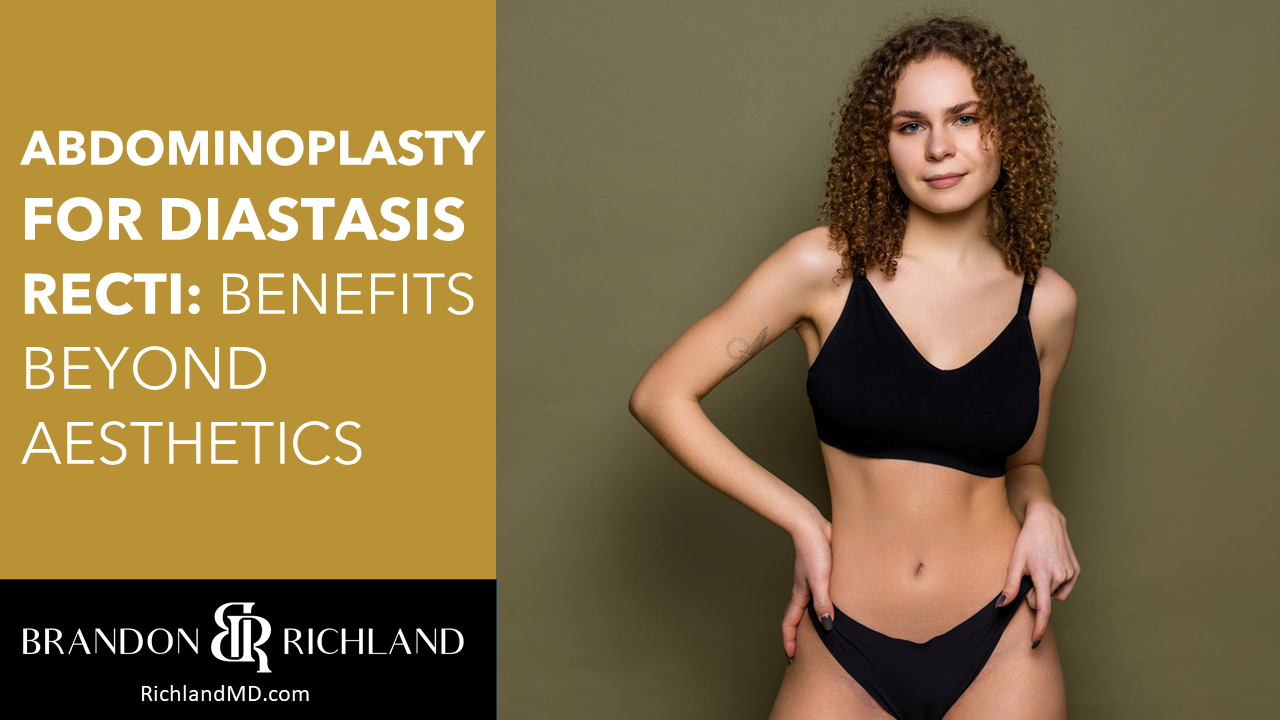Published by Dr. Brandon Richland, MD

A tummy tuck, or abdominoplasty, helps to remove excess skin and tighten abdominal muscles. This procedure is particularly beneficial for those with diastasis recti, the separation of abdominal muscles after pregnancy. Diastasis recti is a condition where the abdominal muscles separate and cause a distressing issue.
Key Takeaways of Abdominoplasty for Diastasis Recti
- Diastasis recti is a condition in which the abdominal muscles separate, leading to bulging and other problems like back pain and urinary incontinence.
- Treatments for diastasis recti range from conservative measures such as lifestyle modifications and exercise to medical intervention including abdominoplasty surgery.
- Benefits of undergoing abdominoplasty includes improved strength and stability in abdomen, reshaping of midsection area, plus elimination or reduction of protruding belly due to separated abdominal muscles.
Understanding Diastasis Recti
Diastasis recti is a common condition, occurring when the distance between the two sides of the rectus abdominis muscle at the midline grows beyond what is considered normal. The rectus abdominis muscles are connected by a band of strong collagen fibers known as Linea Alba. Weakening of these connections can lead to an increase in size and cause them to diverge towards either side.
The most common causes for diastasis recti are pregnancy and significant or rapid weight gain or loss, both leading to deformation or weakness in the abdominal wall muscles resulting in visible bulges or protrusions beneath the skin surface.

Risk Factors of Diastasis Recti
Diastasis recti is a condition in which the abdominal muscles become stretched or weakened, leading to a gap between them. This can happen among both men and women, but it is common during pregnancy due to increased pressure on abdominal muscles contract the abdomen.
While diastasis recti can often be managed with exercise, some cases may require surgical intervention such as an abdominoplasty. Understanding risk factors for developing this condition can help individuals make decisions about preventative measures they could take, if possible.
Common risk factors include having multiple pregnancies, maternal age of over 35 years old at birth of first child, cesarean birth delivery method, carrying a macrosomia baby which is larger than normal newborn, ethnicity, and heavy lifting.
Complications of Diastasis Recti
Diastasis recti can lead to a range of complications if left untreated, such as hernias, back pain, and urinary incontinence. Hernias are common in people with diastasis recti because the weakened abdominal muscles lack the necessary strength to protect organs or cover for internal ailments.
Back pain is also a common complication since it puts extra strain on the spine and pelvic area due to postural pressure from a widened muscle gap. Urinary incontinence is another problematic symptom associated with diastasis recti as weak abdominal muscles affect bladder control, making basic tasks like coughing very uncomfortable and leading to involuntary leaking of urine.
People suffering from chronic pain from this condition must be proactive in seeking medical assistance sooner rather than later before things get worse due to an increased chance that these symptoms will worsen over time without professional help.
Treatment Options for Diastasis Recti
Non surgical treatments like physical therapy and wearing supportive garments and modifications to lifestyle can help in relieving symptoms of diastasis recti, but surgery remains the only reliable long term solution for treating this condition.
Can You Fix Diastasis Recti With Exercise?
Exercise is a recommended approach to treating mild cases of diastasis recti. Physical therapy and home exercises can be effective in improving this condition, but it’s important to choose exercises carefully as some like planks and sit ups are known to exacerbate the separation of abdominal muscles.
Exercise, such as crunches, may help with mild cases of diastasis recti, but more severe cases require surgical intervention to help repair these separated muscles.

Other Treatment Options
A wide range of treatments are available to help treat diastasis recti, including specific therapies, exercises and self care measures. Physiotherapy is the first line of treatment for less severe cases as it can improve abdominal strength and help reduce symptoms such as urinary incontinence.
Specific therapies that focus on repairing diastasis recti include connective tissue release, Maitland approach therapy, and core restoration training. Exercises such as reverse crunches, planks and pelvic floor exercises aim at strengthening these weakened muscles by helping close the gap in the midline between them, which may also be part of physical therapy sessions.
Abdominoplasty as a Solution
A tummy tuck can be an effective procedure for remedying diastasis recti. During a tummy tuck procedure, permanent sutures may be used to reconnect the fascia between those muscles and repair any other muscle separation being found there. This reconnection provides support to the weakened or overstretched abdomen wall as well as adding back much needed stability to your core.
Removing fatty deposits and excess skin from surrounding regions helps create smooth contours along your waist while simultaneously reinforcing already existing tissue in that area.
Benefits of Tummy Tuck for Diastasis Recti
Tummy tuck tightens and strengthens weakened or separated muscles, removes excess skin and fat deposits, and can make your abdomen look firmer and flatter.
For people struggling with diastasis recti, when the abdominal muscles separate on either side of the midline during pregnancy giving birth or rapid weight loss, a tummy tuck may be an effective solution.
This surgery repairs loose intra abdominal fascia that pulls away from each side of the midline, while eliminating stubborn fat deposits as well as removing any loose or sagging skin in order for your stomach to regain its original shape.
Frequently Asked Questions About Abdominoplasty For Diastasis Recti
1. What is Diastasis Recti?
Diastasis recti is a medical condition in which the abdominal muscles separate too far away from each other.
2. Who Should Consider Abdominoplasty for Diastasis Recti?
Abdominoplasty may be beneficial for those who have no other means of addressing their diastasis recti, due to pregnancy or age related reasons such as being over 40 years old.
3. How Does Abdominoplasty Help with Diastasis Recti?
Abdominoplasty tightens stretched muscles and skin around the abdomen to bring them back together and reduce the appearance of a pooch. This can improve symptoms associated with diastasis recti, such as lower back pain and increased intra abdominal pressure.
4 . Are There Any Risks Associated with an Abdominoplasty?
The risks associated with an abdominoplasty include infection, bleeding, scarring, anesthesia risks, nerve damage, and fluid accumulation under the skin or seroma. It’s important to speak to your doctor about potential complications before undergoing surgery.

Conclusion and Summary of Abdominoplasty for Diastasis Recti: Benefits Beyond Aesthetics
A tummy tuck involves surgically repairing the separated abdominal muscles and removing excess skin and fat from the abdomen, resulting in a flatter and more even toned abdomen appearance above an umbilical scar that can be hidden under clothing. Plastic surgeons are especially recommended for performing diastasis recti surgery since they specialize in advanced techniques required for successful outcomes with minimal risks associated with surgery.
During tummy tuck surgery, excess fat and skin may be removed along with repair of separated abdominal muscles that cause diastasis recti, offering to many women an improved sense of wellbeing due to its aesthetic results and body contouring effects, creating a more firm abdomen than what could be achieved through exercising alone.
While there are potential risks associated with any form of surgery, benefits from tummy tuck include improved strength and stability in the core, shaping of the midsection, and elimination or reduction of protruding belly caused by separated abdominal muscles.
Insurance plans may cover some or all of the cost depending on individual needs. It is important to contact a qualified physician and your insurance provider prior to undergoing abdominoplasty for diastasis recti repair.
Please note that this article is intended for informational purposes only and should not be construed as medical advice. Before making any changes to your treatments, please consult with your healthcare provider to discuss the appropriateness and safety of such changes.
Ready For Your First-Class Cosmetic Experience in Orange County (OC) California (CA)?
Are you located in one of these Orange County (OC) / Southern California cities?
Aliso Viejo, Anaheim, Brea, Buena Park, Costa Mesa, Coto de Caza, Cypress, Dana Point, Fountain Valley, Fullerton, Garden Grove, Huntington Beach, Irvine, La Habra, La Palma, Laguna Beach, Laguna Hills, Laguna Niguel, Laguna Woods, Ladera Ranch, Lake Forest, Los Alamitos, Mission Viejo, Newport Beach, Orange, Placentia, Rancho Santa Margarita, San Clemente, San Juan Capistrano, Santa Ana, Seal Beach, Stanton, Tustin, Villa Park, Westminster, or Yorba Linda?
Plastic Surgeon Dr. Brandon Richland, MD and our Cosmetic Aesthetics Team are ready to help you look and feel your absolute best.
Elevate your confidence and self esteem levels to unfathomable new heights!
Schedule your in-person consultation in our modern and luxurious offices in either Fountain Valley, CA (Main HQ) or our Newport Beach, CA office.
Do you live outside of Southern California or short on time? For your convenience, Virtual Consultations are also available.
Our warm and engaging Team of carefully selected Aesthetics Professionals will make you feel calm, cool, collected, and right at home throughout your entire consultation and surgery process.
Schedule Your Aesthetics Consultation here, or call us directly at 949-867-4496 today.
About the Author

Dr. Brandon Richland, MD is a respected Board Certified Licensed Plastic Surgeon in Orange County / Southern California specializing in cosmetic and reconstructive surgeries.
Driven by his passion for medicine, Dr. Richland obtained his Doctor of Medicine (M.D.) degree from the prestigious program at Saint Louis University (SLU) School of Medicine in 2013. His exceptional skills were recognized when he received the McGraw Hill / Lange Medical Student Academic Achievement Award, and graduated top of his class with Honors. For his undergraduate degree, he attended University of California, Los Angeles (UCLA) and graduated with Honors in 2009.
To further enhance his surgical expertise, Dr. Richland completed his Residency in Plastic Surgery at the University of California, Irvine (UCI) from 2013 to 2019 earning the Academic Achievement Award twice during this period. A total of 14 years in dedicated schooling and medical residency.
Dr. Richland is actively involved with healthcare and medical societies, as a Diplomate of the American Board of Plastic Surgery, a member of the American Society of Plastic Surgeons, American Society of Aesthetic Plastic Surgeons, and the California Society of Plastic Surgeons.
Contact Dr. Richland today by visiting RichlandMD.com, scheduling a cosmetic consultation, or by calling 949-867-4496 directly.
Cover Image Credit: F8studio / 123RF.com (Licensed). Photo Illustration by: Dr. Brandon Richland, MD.










